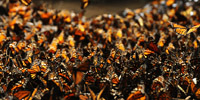From the African savannah to the frigid waters off Antarctica, from a Pacific island to the skies of North America, the mass movement of millions of creatures from one place to another is one of the most astonishing of all natural phenomena. But scientists who study the migration of creatures as disparate as the monarch butterfly and the southern elephant seal are motivated by more than just curiosity.
For migratory species, “put simply, migration is crucial for survival,” writes nature journalist and Zoological Society of London fellow Ben Hoare in his 2009 book, Animal Migration: Remarkable Journeys in the Wild. “It has evolved to enable animals to spend their life in two or more different areas, usually because a lack of food or a period of extreme weather makes it impossible to remain in the same location permanently.” Migratory animals also are driven by other imperatives, such as the need to find water or a mate, or to reach a place where they can reproduce.
Scientists also know that increasingly, many of these migratory species are threatened by the spread of human civilization, which increasingly encroaches upon their habitat and sometimes blocks access to the routes that species may have used for thousands of years. Additionally, humans sometimes compete with migratory animals for food or water sources, or destroy them through development.
“Saving the great migrations will be one of the most difficult conservation challenges of the 21st century,” according to ecologist David S. Wilcove, a Princeton University professor and author of the 2008 book No Way Home: The Decline of the World’s Great Animal Migrations. But if we fail to do so, we will pay a heavy price — aesthetically, ecologically, and even economically.” In the 19th and early 20th century, Wilcove notes, human hunting and destruction of habitat in North America drove the migratory passenger pigeon, once one of the most prolific species on the planet, into extinction. But even if species such as the wildebeest and the monarch butterfly manage to survive, he warns, their numbers may be so severely reduced that ecosystems in which they play an important role will be seriously damaged.
Researchers hope that by learning more about why and how species migrate, they’ll be able to better protect them from disruption by humans.

There are still major gaps in scientists’ understanding of animal migration. Little is known, for example, about the migration patterns of species such as the great white shark, which does much of its traveling on the open seas and descends to depths where it is difficult to observe. But in a 2008 article for the online journal PLoS Biology, Wilcove and fellow migratory researcher Martin Wikelski write that the greatest single challenge may lie in understanding the demographic connectivity of migration — that is, how events at one stage of the migratory cycle affect other stages and the overall population growth of a species.
For example, Wilcove and Wikelski write, over the past three decades hundreds of researchers have studied in detail the decline in populations of migratory songbirds in eastern North America and Europe, and published thousands of scientific papers on the subject. Yet even after all this work, no one has been able to determine precisely what is reducing the number of birds — whether it is primarily caused by loss of breeding, wintering or water habitat, mortality along the route from pesticides or the presence of communications towers, or some combination of these and other factors.
Another important scientific challenge, according to Wilcove and Wikelski, is figuring out the “decision rules” by which migratory animals determine where to go, how long to stay and when to leave. Learning more about the environmental cues that trigger migration could help scientists to predict the extent to which migration will be altered or disrupted by climate change.
Fortunately, scientists now have more tools than ever before to provide new data and possible insights about migration. Advances in miniaturization of electronics, for example, has enabled them to attach tiny radio frequency identification tags (RFIDs) to monarch butterflies, to track their movements. Tracking and monitoring devices also can be attached to aquatic creatures such as great white sharks, enabling researchers to follow them and record data about their behavior. Such a device attached to a female great white by Australian researchers in 2003, for example, revealed that the animal swam an astonishing 12,400 miles in a nine-month period, migrating from South Africa to Australia and back. As a result, scientists now know that the species spends much of its time in the open ocean, and that different populations of great whites may be more closely connected than previously thought. They also now know that the species, which is protected along the coastlines of Australia and other countries, may be more vulnerable to open-ocean fishing than anyone had realized.
But learning more about animal migration is just the first step. If we are to avoid having more of the planet’s migratory species go the way of the once-abundant passenger pigeon, it’s vital for the information to be put to use to protect nature’s magnificent and sublime travelers. As Wilcove and Wikelski write: “If we are successful, it will be because governments and individuals have learned to act proactively and cooperatively to address environmental problems, and because we have created an international network of protected areas that is capable of sustaining much of the planet's natural diversity.”












